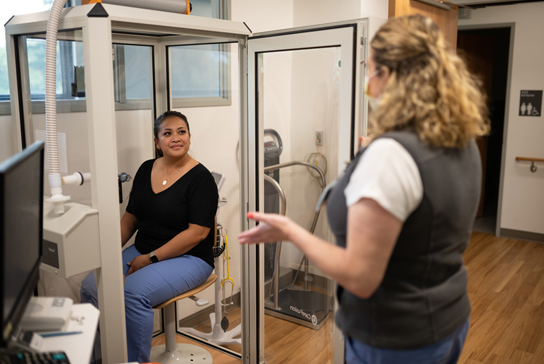Pulmonary Function
What is the pulmonary system
The pulmonary system involves the movement of blood between the heart and lungs. The system works at both removing carbon dioxide (CO2, a waste product) from the blood and absorbing oxygen into the blood to transport it from the lungs to the heart for supply to the rest of the body. Exercise or activity increases the body’s need for oxygen significantly; therefore the pulmonary system must increase its function to supply more oxygen. In the presence of some lung diseases such as Chronic Obstructive Pulmonary Disease (COPD), the pulmonary system is limited or in some cases unable to transport an adequate amount of oxygen during rest; not to mention exercise.


The Pulmonary Function Test
A pulmonary function test (PFT) is an assessment of how well the lungs perform by measuring the amount of air the lungs can take in during one inhale and how quickly it can be expelled. It can be used to determine abnormalities and even screen for some lung diseases. It can also be used to evaluate the efficacy of a treatment for a lung disease or to get a baseline measurement of lung capacity.
The single test yields the following three measurements:
- The volume of air that can be maximally forcefully exhaled after a maximal inhalation. Lower than normal results may suggest obstructive or restrictive lung disease.
- The volume of air that is forcefully exhaled in one second after a maximal inhalation. Lower than normal results may suggest obstructive or restrictive lung disease.
- Ratio of FEV1 to FVC (FEV1/FVC): The percentage of the total FVC that is forcefully exhaled in the first second. When both FVC and FEV1 fall below normal, and FEV 1.0/FVC is lower than normal, that can suggests obstructive lung disease such as asthma.
The normal values are based upon the percent of predicted values, or how well you performed against your predicted values. Predicted values are based on your height, age, gender and race.
Interpretation: This test can be highly effort-dependent and other factors can affect your results (e.g. dentures), so it may be necessary that the physician or physiologist interpret your results subjectively. Otherwise, the following may be used to define your results:
- Normal PFT Outcomes - > 80% of predicted values
- Mild Disease - 65% to 80% of predicted values
- Moderate Disease - 50% to 65% of predicted values
- Severe Disease - < 50% of predicted values
It is also important to understand that this test may not be conclusive in determining the presence of disease. It can suggest the beginning stages of disease or determine any limitations to physical activity or even job responsibilities. A more formal pulmonary function study that measures lung volumes is necessary to diagnose restrictive lung disease and to add additional support for the diagnosis of obstructive lung disease. Your physician will take all factors into consideration when interpreting your results and he/she can determine if further lung function testing is necessary.
Lung disease is the major health concern when considering a pulmonary test. There are two major categories of lung diseases — restrictive and obstructive. Restrictive lung disease is characterized by a decreased ability to move air into the lungs due to the decreased elasticity of the lung tissue or other physical abnormalities of the lung or thoracic wall. Obstructive lung disease is characterized by a decreased ability to move air out of the lungs, caused by a narrowing or blockage of the airways.
The most common obstructive disorder is Chronic Obstructive Pulmonary Disease (COPD), which is a condition marked by progressive coughing, wheezing and shortness of breath that can drastically restrict daily activities. Emphysema and chronic bronchitis are all forms of COPD. Smoking is the leading cause of COPD. All types of COPD can be screened with a pulmonary function test and diagnosed with a special diagnostic test.
Distressed pulmonary responses can be triggered by exercise, especially at higher intensities or when transitioning from one intensity level to another, even when the intensity is low. Most patients who have some air way restrictions/obstructions benefit from long or short acting medications that uninhibited breathing and allow them to engage in exercise unencumbered. Besides medication, some clients will see symptoms mitigated with a well planned steady warm-up, exercising during appropriate outdoor conditions (low pollen counts, minimal winds, mild temperatures, etc...), or doing indoor workouts.
